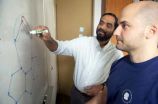(Press-News.org) DURHAM, N.C. – Tinkering with a single gene may give perennial grasses more robust roots and speed up the timeline for creating biofuels, according to researchers at the Duke Institute for Genome Sciences & Policy (IGSP).
Perennial grasses, including switchgrass and miscanthus, are important biofuels crops and can be harvested repeatedly, just like lawn grass, said Philip Benfey, director of the IGSP Center for Systems Biology. But before that can happen, the root system needs time to get established.
"These biofuel crops usually can't be harvested until the second or third year," Benfey said. "A method to improve root growth could have a major role in reducing the time to harvest for warm season grasses."
Benfey's team appears to have found a way to do just that. They took a directed genomic approach aimed at identifying genes that become active when cells stop dividing and start taking on the characteristics of the mature, adult cell they are to become. "We systematically looked for those genes that come 'on' precisely when cells transition from proliferation to differentiation and then turn 'off' again just as quickly," Benfey said.
That genome-wide search in the roots of the familiar laboratory plant Arabidopsis and subsequent screening of mutant lines turned up a single gene, which the researchers call UPBEAT1 (UPB1). Further study showed that UPB1 controls the gene expression of enzymes known as peroxidases.
They then showed that these peroxidases control the balance of free radicals between the zone of cell proliferation and the zone of cell elongation where differentiation begins. (Although free radicals are probably most familiar as agents of stress to be combated with antioxidants, Benfey noted that the balance of free radicals has also been implicated in the control of a similar transition from proliferation to differentiation in animals.)
When the researchers experimentally disrupted UPB1 activity in the plant root, it altered the balance of free radicals such that cells delayed their differentiation and continued growing. Those plants ended up with faster-growing roots, having more and larger cells. When UPB1 activity was artificially increased, the growth of plant roots slowed.
"It's possible that by manipulating a single gene, you could get a plant with rapid growth," Benfey said. Interestingly, UPB1 appears to act independently of plant hormones that play well-known roles in the balance between cell division and differentiation.
From an engineering perspective, the prospect of enhancing growth by taking a gene away, as opposed to adding one, is particularly appealing, Benfey notes.
"It also suggests that plants are not growing at their full potential," he says. That makes sense, of course, as plants in the real world have to make tradeoffs, for example, between growth and reproduction.
In addition to their potential in biofuels production, the findings might also lead to new ways to produce bigger and stronger plants with the capacity to sequester more earth-warming carbon dioxide from the atmosphere, Benfey says. His startup company, GrassRoots Biotechnology Inc., has acquired the patent for this discovery with its potential in mind. The company's primary goals are the development of next-generation biofuels and the use of root systems for carbon sequestration.
###
Collaborators on the NSF-funded study, which appears in the November 12th issue of the journal Cell, include Hironaka Tsukagoshi and Wolfgang Busch, both at Duke.
END
STANFORD, Calif. — One protein single-handedly controls the growth of blood vessels into the developing brains of mice embryos, according to researchers at the Stanford University School of Medicine. Understanding how the protein, a cellular receptor, functions could help clinicians battle brain tumors and stroke by choking off or supplementing vital blood-vessel development, and may enhance the delivery of drugs across the blood-brain barrier.
"The strength and specificity of this receptor's effects indicate that it could be a very important target," said Calvin Kuo, ...
Bethesda, MD—An original and progressive report on health information technology (HIT) vendors, their customers and patients, published online today, makes ground-breaking recommendations for new practices that target the reduction or elimination of tensions that currently mar relationships between many HIT vendors and their customers, specifically with regard to indemnity and error management of HIT systems. In light of the Obama Administration's $19 billion investment in HIT, paid out in ARRA stimulus funds, these recommendations are particularly significant in helping ...
PROVIDENCE, R.I. [Brown University] — The website of the Nobel Prize shows a cat resting in a graphene hammock. Although fictitious, the image captures the excitement around graphene, which, at one atom thick, is the among the thinnest and strongest materials ever produced.
A significant obstacle to realizing graphene's potential lies in creating a surface large enough to support a theoretical sleeping cat. For now, material scientists stitch individual graphene sheets together to create sheets that are large enough to investigate possible applications. Just as sewing ...
SANTA CRUZ, CA--A bulge of elevated topography on the farside of the moon--known as the lunar farside highlands--has defied explanation for decades. But a new study led by researchers at the University of California, Santa Cruz, shows that the highlands may be the result of tidal forces acting early in the moon's history when its solid outer crust floated on an ocean of liquid rock.
Ian Garrick-Bethell, an assistant professor of Earth and planetary sciences at UC Santa Cruz, found that the shape of the moon's bulge can be described by a surprisingly simple mathematical ...
ANN ARBOR, Mich.---Strategies for preventing the spread of whooping cough---on the rise in the United States and several other countries in recent years---should take into account how often people in different age groups interact, research at the University of Michigan suggests.
The findings appear in the Nov. 12 issue of the journal Science.
Thanks to widespread childhood vaccination, whooping cough (pertussis) once seemed to be under control. But the illness, which in infants causes violent, gasping coughing spells, has made a comeback in some developed countries ...
Boston, Mass. - While it has become clear in recent years that susceptibility to pain has a strong inherited component, very little is known about actual "pain genes" and how they work. In the November 12th issue of Cell, researchers at Children's Hospital Boston and their collaborators report on a novel human pain gene. People with minor variations in this gene showed clear differences in susceptibility to acute heat pain and chronic back pain. Corroborating mouse studies give some clues as to how the gene controls pain sensitivity. The gene was uncovered in a genome-wide ...
Controlling and modulating the flow of light is essential in today's telecommunications-based society. Professor Tobias Kippenberg and his team in EPFL's Laboratory of Photonics and Quantum Measurements have discovered a novel way to couple light and vibrations. Using this discovery, they built a device in which a beam of light traveling through an optical microresonator could be controlled by a second, stronger light beam. The device thus acts like an optical transistor, in which one light beam influences the intensity of another.
Their optical microresonator has two ...
Individuals who suffer from severe acne are at an increased risk of attempting suicide, according to a paper published on bmj.com today.
The study also finds that an additional risk may be present during and up to one year after treatment with isotretinoin, a commonly prescribed drug for severe acne. However, the authors stress that this additional risk is most likely due to the acne itself, rather than the drug treatment.
Isotretinoin (commonly marketed as Roaccutane, Accutane, Amnesteem, Claravis, Clarus or Decutan) has been used to treat severe acne since the 1980s. ...
New research has revealed up to 16,000 endangered turtles are being caught each year by villagers in just one region of Madagascar, despite a government ban.
Researchers from the University of Exeter and Blue Ventures Conservation say the figure, thought to be a conservative estimate, is the first direct assessment of turtle exploitation on the island.
The study highlights the extent of small-scale fishing, traditionally very difficult to monitor, and could be vital in finding a way to sustainably manage turtle fishing in the region.
Dr Annette Broderick, from the ...
"The biggest surprise to me was that we could rescue the autistic phenotype [in the human cells] to something close to normal," said Alysson Muotri of the University of California San Diego.
The researchers made the discovery by first transforming adult cells taken from patients with Rett Syndrome into induced pluripotent stem cells (iPS cells) using an established cocktail. iPS cells look and act very much like embryonic stem cells.
Those stem cells were able to form functional neurons in cell culture. However, neurons derived from Rett Syndrome patients exhibited ...


